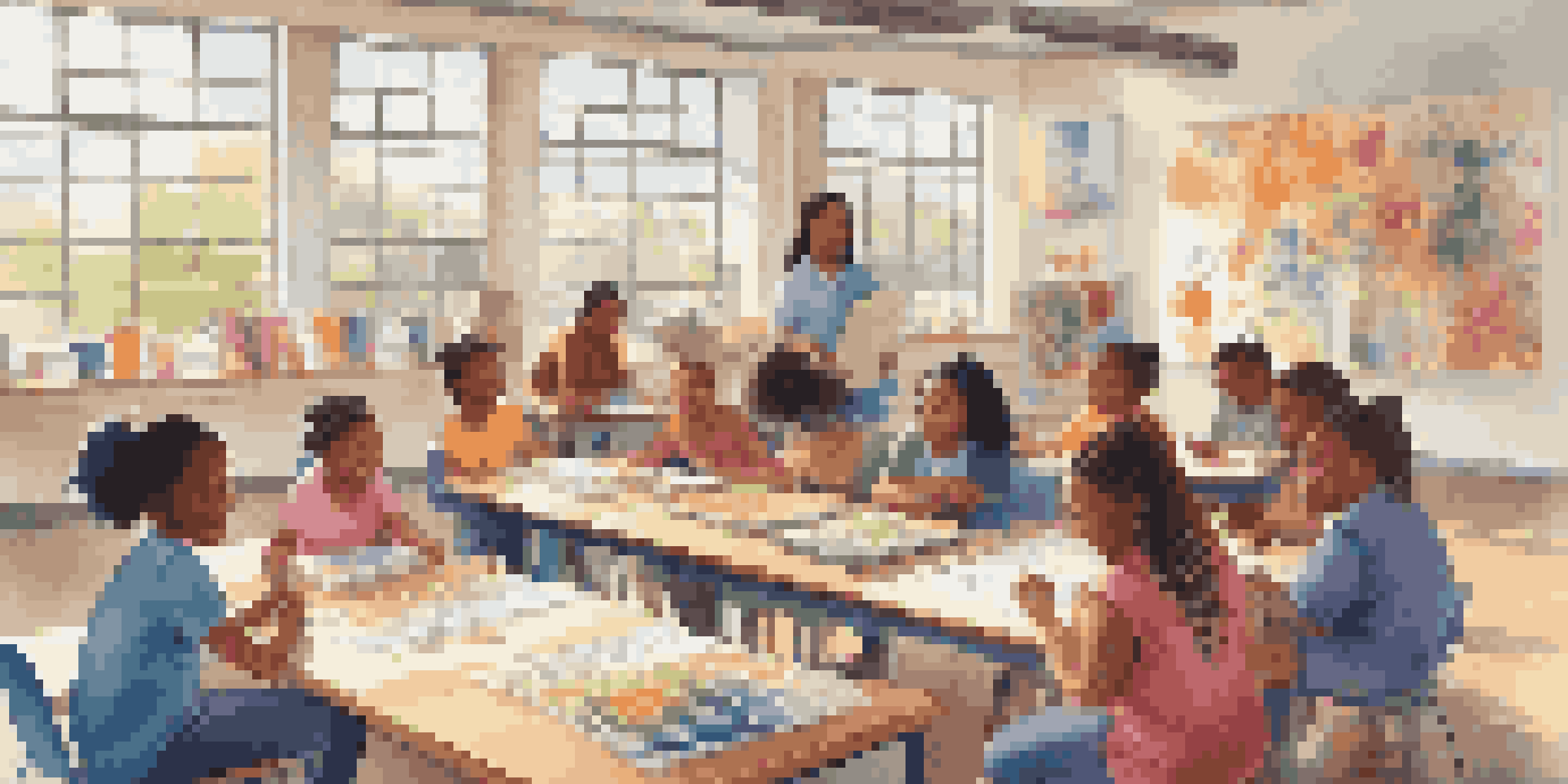The Influence of Social Learning on Youth Behavioral Trends

Understanding Social Learning and Its Importance
Social learning theory, developed by Albert Bandura, emphasizes that people learn from one another through observation and imitation. This concept is particularly significant for youth, as they are in a developmental stage where they are highly impressionable. When young people observe the behaviors, attitudes, and outcomes of others, especially peers and role models, they often mimic these actions. This learning process can significantly influence their choices and behaviors in various contexts, from school to social interactions.
We learn from our interactions with others; it is through observation and imitation that we develop our understanding of the world.
Consider a teenager who sees their friends successfully using social media to gain popularity. They are likely to adopt similar behaviors, believing that this will yield positive outcomes for them too. This illustrates how social learning operates in everyday life, highlighting its relevance in shaping youth behavior. In a world saturated with digital interactions, the impact of social learning becomes even more pronounced.
Moreover, social learning can occur in both positive and negative contexts. For instance, witnessing acts of kindness can encourage altruistic behaviors among peers, while exposure to risky behaviors, like substance abuse, can lead to negative outcomes. Understanding the dual nature of social learning is crucial for parents and educators to guide youth toward positive influences.
Peer Influence: A Powerful Catalyst for Change
One of the most significant facets of social learning for youth is the influence of peers. During adolescence, individuals are particularly attuned to their social circles, often prioritizing peer acceptance over parental guidance. This can lead to a strong desire to conform to the behaviors and trends exhibited by friends, whether they are positive or negative. For example, if a group of friends starts a new trend, like a particular fashion style or a viral dance, others are likely to jump on board.

This phenomenon is often seen in school environments, where students may adopt certain behaviors to fit in. A classic example is the pressure to perform well academically or participate in extracurricular activities that are popular among peers. This kind of social learning can foster a sense of belonging, but it can also lead to unhealthy competition or stress if the pressures become too intense.
Social Learning Shapes Youth Behavior
Young people learn behaviors and attitudes through observation and imitation of their peers, role models, and digital influencers.
Ultimately, the role of peers in shaping youth behavior underscores the importance of positive social environments. When young people are surrounded by supportive friends who encourage healthy habits and constructive behaviors, the outcomes are typically beneficial. On the flip side, negative peer influence can lead to risky behaviors, making it essential for youth to choose their social circles wisely.
The Role of Technology in Social Learning
In today’s digital age, technology plays a pivotal role in social learning among youth. Platforms like TikTok, Instagram, and YouTube are not merely entertainment; they are powerful tools for learning and imitation. Young people often look to influencers and content creators for inspiration, adopting trends that they see online. This can range from fashion to lifestyle choices, illustrating how social media shapes youth behavior.
The influence of peer pressure can shape a young person's choices, sometimes in ways that can lead to great success or unfortunate consequences.
However, while technology can provide positive role models, it also comes with risks. The prevalence of harmful content can lead to the adoption of negative behaviors, such as cyberbullying or unhealthy body image issues. Parents and guardians must navigate this digital landscape alongside their children, educating them about the importance of critical thinking and discernment when consuming online content.
Moreover, technology can also facilitate positive social learning experiences. Online communities can offer support and encouragement for youth pursuing shared interests, such as fitness challenges or artistic endeavors. By leveraging technology wisely, we can create a balanced approach to social learning that nurtures young people's growth and development.
Family Influence: The First Teachers
While peers and technology have a significant impact, family remains the cornerstone of social learning. From a young age, children observe their parents and siblings, often mimicking their behaviors and attitudes. This foundational learning shapes their understanding of social norms and expectations. For instance, a child who sees their parents engaging in regular community service is more likely to adopt similar values of kindness and generosity.
However, the dynamics within a family can vary greatly, influencing the type of behaviors that are learned. Positive reinforcement, open communication, and healthy relationships contribute to constructive learning experiences. Conversely, negative interactions or a lack of support can lead to maladaptive behaviors and challenges in social situations.
Peer Influence Drives Choices
During adolescence, peer acceptance often outweighs parental guidance, leading youth to adopt behaviors that reflect their social circles.
Ultimately, families play a crucial role in setting the groundwork for social learning. By fostering a loving and supportive environment, families can empower youth to make positive choices and develop strong moral compasses as they navigate social landscapes.
The Impact of Cultural Context on Behavior
Cultural context significantly shapes the way social learning occurs among youth. Different cultures prioritize various values and behaviors, which can influence how young people learn from one another. For instance, in collectivist cultures, youth may learn the importance of community and cooperation, while in more individualistic cultures, personal achievement and independence might be emphasized.
This cultural lens can affect everything from communication styles to social interactions. For example, in some cultures, demonstrating respect for elders is crucial, which can lead youth to adopt polite behaviors and conflict resolution strategies. On the other hand, cultures that encourage assertiveness may foster more outspoken youth who are comfortable expressing their opinions.
Understanding the cultural context of social learning helps educators and parents tailor their approaches to better resonate with youth. By acknowledging and respecting diverse backgrounds, we can create more inclusive environments that promote positive behaviors and foster growth.
Encouraging Positive Social Learning Environments
As we explore the influence of social learning on youth behavior, it's vital to discuss how we can create positive environments for this learning to thrive. Schools and communities can implement programs that promote teamwork, empathy, and constructive communication. Activities like group projects, community service, and peer mentoring can foster positive interactions that benefit all involved.
Additionally, parents can play an active role by encouraging open discussions about behavior and its consequences. When youth feel safe expressing their thoughts and experiences, they are more likely to engage in positive social learning. This could involve talking about the influence of peers or discussing the media they consume, helping them develop critical thinking skills.
Family Sets the Foundation
Family dynamics play a crucial role in shaping social learning, as children often mimic the values and behaviors demonstrated by their parents and siblings.
By intentionally cultivating an environment that supports positive social learning, we can equip youth with the tools they need to navigate their social world effectively. This proactive approach can lead to healthier behaviors and more resilient young individuals.
The Future of Social Learning and Youth Behavior
Looking ahead, the future of social learning and its impact on youth behavior is both exciting and complex. As technology continues to evolve, new platforms and methods of interaction will emerge, shaping how young people learn from one another. This rapid change presents opportunities for positive engagement but also challenges in terms of managing negative influences.
By focusing on education and awareness, we can prepare youth to navigate these changes effectively. Encouraging critical thinking about social media consumption, peer relationships, and cultural influences will empower young people to make informed choices. The goal is to cultivate a generation that is not only aware of the influences around them but also capable of shaping their own positive behaviors.

In summary, the dynamic interplay of social learning, technology, and cultural context will continue to evolve. By fostering supportive environments and encouraging positive behaviors, we can help guide youth towards a future characterized by resilience, empathy, and constructive social interactions.